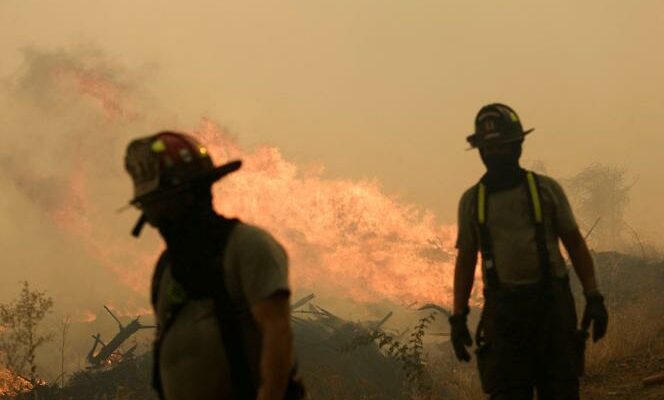A line of fire, seen from the sky, advancing implacably on the forest; helpless firefighters standing in front of a wall of flames; inhabitants who, despite the size of the fires, try to smother them, in an artisanal way, with buckets of water. The violent fires that have raged in Chile since 1er February, in the middle of the austral summer, deliver their batches of apocalyptic images. The so-called center-south region of the country – the provinces of Maule, Nuble, Biobio and Araucanie, from 280 km south of Santiago – thus saw thousands of hectares totally destroyed. The balance sheet, Friday, February 10: twenty-four dead, 1,250 homes disappeared, more than 2,000 people taken care of by the health services. In total, more than 373,000 hectares were ravaged. These are the worst fires after those of 2017, during which 467,000 hectares were devoured.
President Gabriel Boric (left) announced on Wednesday “very difficult days”, while the fires had already been raging for a week. He called for everyone’s cooperation, including the private sector. “In five days, we see an area burned equivalent to two years [normales] fire », assessed Carolina Toha, Minister of the Interior, on Monday. This week more than 5,600 Chilean firefighters continued to fight the flames, supported by international aid. It has flown in from different countries: Argentina, Mexico but also Spain, the United States, with the sending of material or human resources. France announced on Tuesday the dispatch of 80 firefighters and rescuers. The day before, Emmanuel Macron had assured on Twitter: “The Chilean people can count on the support of France to fight against this scourge. » The European Union has also announced the dispatch of aid: firefighters, doctors and experts.
“But no matter how many planes or how much money was spent fighting the fires, they got out of hand”, observes Roberto Rondanelli meteorologist at the University of Chile. On Friday, 321 homes were still active. The experts are categorical: the origin of the fires is above all human, criminal or accidental. “There is a legitimate suspicion linked to the intentionality [des feux]which is under investigation., said Gabriel Boric on Wednesday. At least twenty-eight people were arrested.
However, a series of factors explain the speed and intensity of the fires. Firstly, climate change, the vector of a historic “mega-drought” in Chile, which has been raging for about 13 years. It results in a historic deficit of precipitation, of the order of 30% between 2010 and 2019, according to a report by the Chilean Research Center for Climate and Resilience (CR2). Over the past fifty years, maximum temperatures during the summer have increased by 0.43 ° C per decade, underlines the research center, in a note published on February 8. “All the events with temperatures exceeding 40°C have occurred in the last decade”continues the research center. Thus, the regions affected by the fires were marked by a heat wave, with temperatures sometimes exceeding the 40°C mark. A high temperature alert was still running until Saturday, for an area encompassing more than 900 km, from north to south (from the Coquimbo region to Nuble).
You have 50.01% of this article left to read. The following is for subscribers only.
